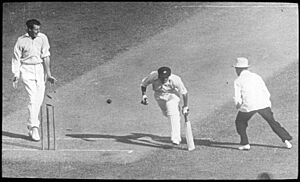Ken Farnes facts for kids

|
||||||||||||||||||||||||||||||||||||||||
| Personal information | ||||||||||||||||||||||||||||||||||||||||
|---|---|---|---|---|---|---|---|---|---|---|---|---|---|---|---|---|---|---|---|---|---|---|---|---|---|---|---|---|---|---|---|---|---|---|---|---|---|---|---|---|
| Born | 11 July 1911 Leytonstone, Essex, England |
|||||||||||||||||||||||||||||||||||||||
| Died | 20 October 1941 (aged 30) near RAF Chipping Warden, Oxfordshire, England |
|||||||||||||||||||||||||||||||||||||||
| Batting | Right-handed | |||||||||||||||||||||||||||||||||||||||
| Bowling | Right-arm fast | |||||||||||||||||||||||||||||||||||||||
| International information | ||||||||||||||||||||||||||||||||||||||||
| National side | ||||||||||||||||||||||||||||||||||||||||
| Test debut | 8 June 1934 v Australia | |||||||||||||||||||||||||||||||||||||||
| Last Test | 3 March 1939 v South Africa | |||||||||||||||||||||||||||||||||||||||
| Career statistics | ||||||||||||||||||||||||||||||||||||||||
|
||||||||||||||||||||||||||||||||||||||||
|
Source: ESPNcricinfo, 7 November 2022
|
||||||||||||||||||||||||||||||||||||||||
Kenneth Farnes (born July 8, 1911 – died October 20, 1941) was a talented English cricket player. He played in 15 Test matches for England between 1934 and 1939.
Contents
Early Life and Cricket Start
Ken Farnes was born in Leytonstone, Essex, England. He went to the Royal Liberty School in Gidea Park. When he was just 19, he started playing first-class cricket for Essex in 1930. In only his second match for Essex, he took 5 wickets for 36 runs against Kent.
Playing for Cambridge
Farnes also studied at Pembroke College, Cambridge. While at university, he played cricket for the Cambridge team for three years. He continued to play for Essex during this time too. After finishing his studies, he became a teacher at Worksop College. This meant he had less time to play cricket for Essex.
Ken Farnes' Cricket Career
In 1933, Ken Farnes had a great year. He took 41 wickets for Cambridge, meaning he got many players out. Overall that year, he took 113 wickets. His excellent performance led to him being chosen for the England team.
Test Debut Against Australia
Farnes made his first Test appearance against Australia in 1934. This important match was played at Trent Bridge. He did incredibly well, taking 5 wickets in each of Australia's innings. Even with his strong performance, England lost the match. He played in the second Test too, but then an injury kept him out of the next two games.
Overcoming Injuries
After playing two more Tests in the West Indies in 1934-1935, a knee injury stopped him from playing in 1935. But he came back strong the next season. He took three quick wickets in a match between the Gentlemen and the Players teams.
Playing in Australia
Because of his good form, Ken Farnes was chosen for the England tour to Australia that winter. He played in the fourth and fifth Tests there. In the fifth Test at the MCG, he took 6 wickets for 96 runs. Despite his efforts, Australia won the match and the series.
Later Test Matches
In 1938, Farnes helped the Gentlemen team win against the Players. He took 8 wickets in the first innings and 3 in the second. He then returned to the England Test team for four matches against Australia in 1938. That winter, he also toured South Africa, where he was one of the main bowlers in five Tests.
Farnes' Bowling Style
Ken Farnes was a very tall man, standing at 6 feet 5 inches. This height helped him bowl very fast even with a short run-up. His height also allowed the ball to bounce higher, making it difficult for batsmen. He was also good at catching balls close to the stumps. As a batsman, he was known as a "tail-ender," meaning he usually batted at the end of the team's batting order. However, in 1936, he scored his highest first-class score of 97 not out against Somerset. He nearly reached a century, putting on a huge partnership for the last wicket.
Life After Cricket
In 1939, Ken Farnes was named a Wisden Cricketer of the Year, a big honor in cricket. He also wrote a book about his experiences called Tours and Tests in 1940.
Joining the Royal Air Force
When Second World War started, Farnes joined the Royal Air Force Volunteer Reserve. He trained as a pilot in Canada. He became a sergeant and then a pilot officer in September 1941.
Tragic End
Sadly, Ken Farnes died shortly after returning to England. The Vickers Wellington plane he was flying crashed during a night-flying exercise. This happened after taking off from RAF Chipping Warden in Oxfordshire. Both Farnes and another pilot officer died in the crash. He is buried at the Brookwood Military Cemetery in Surrey.

